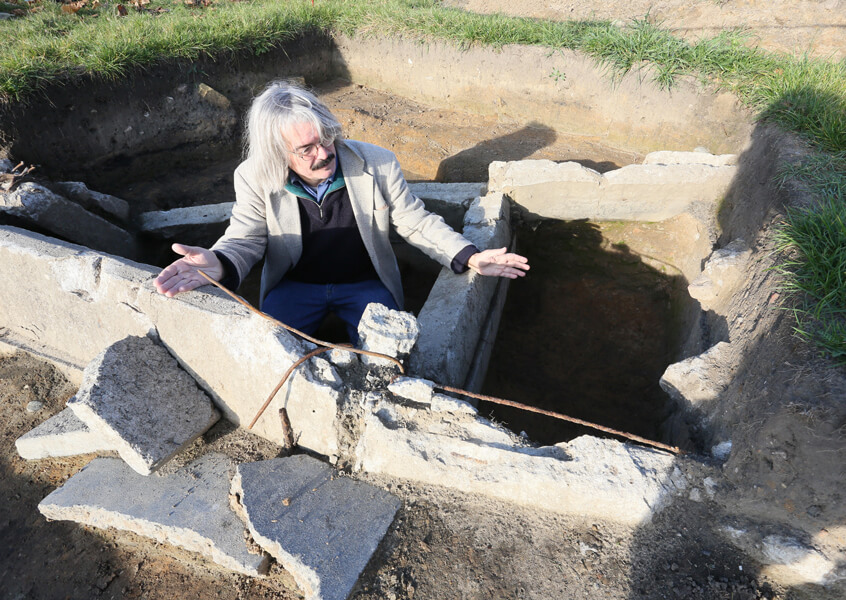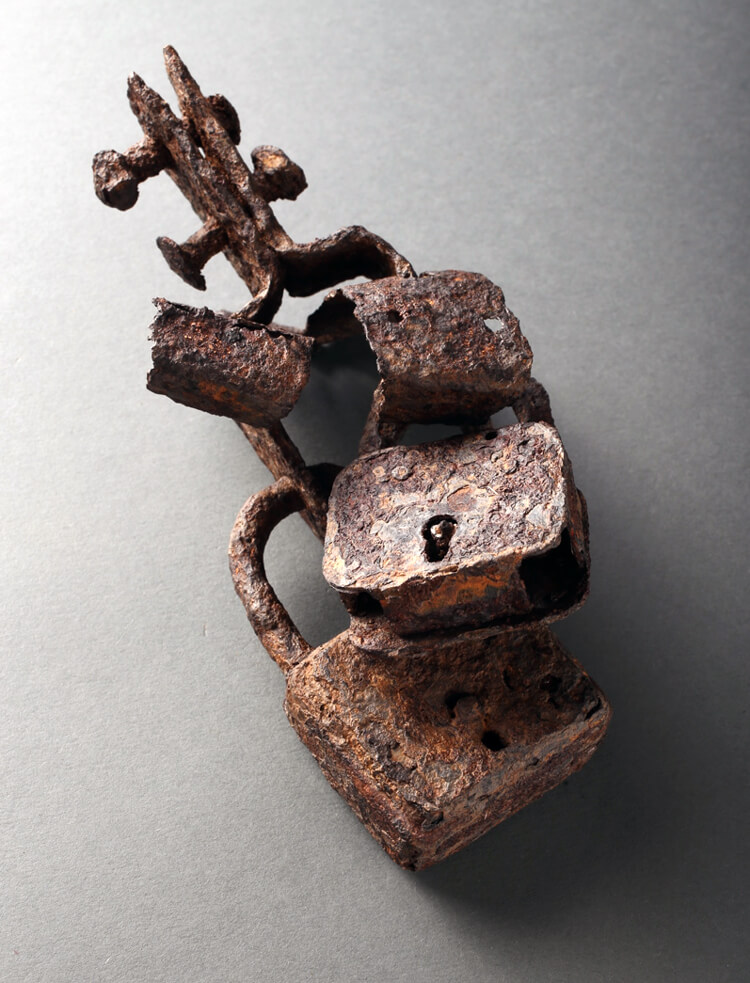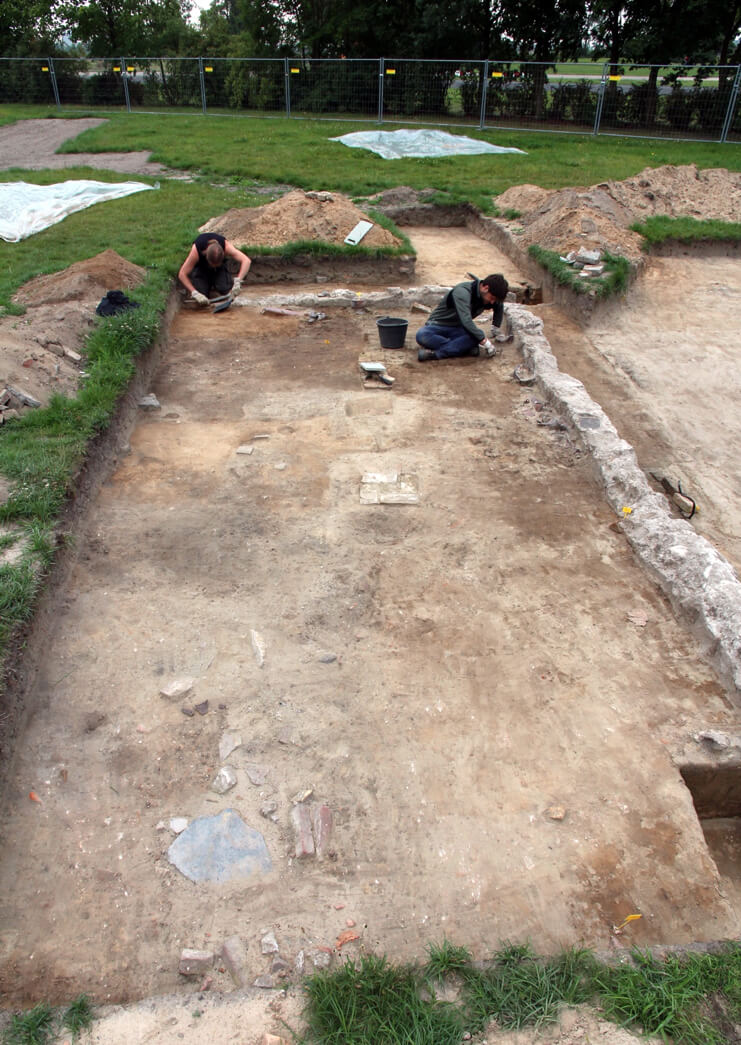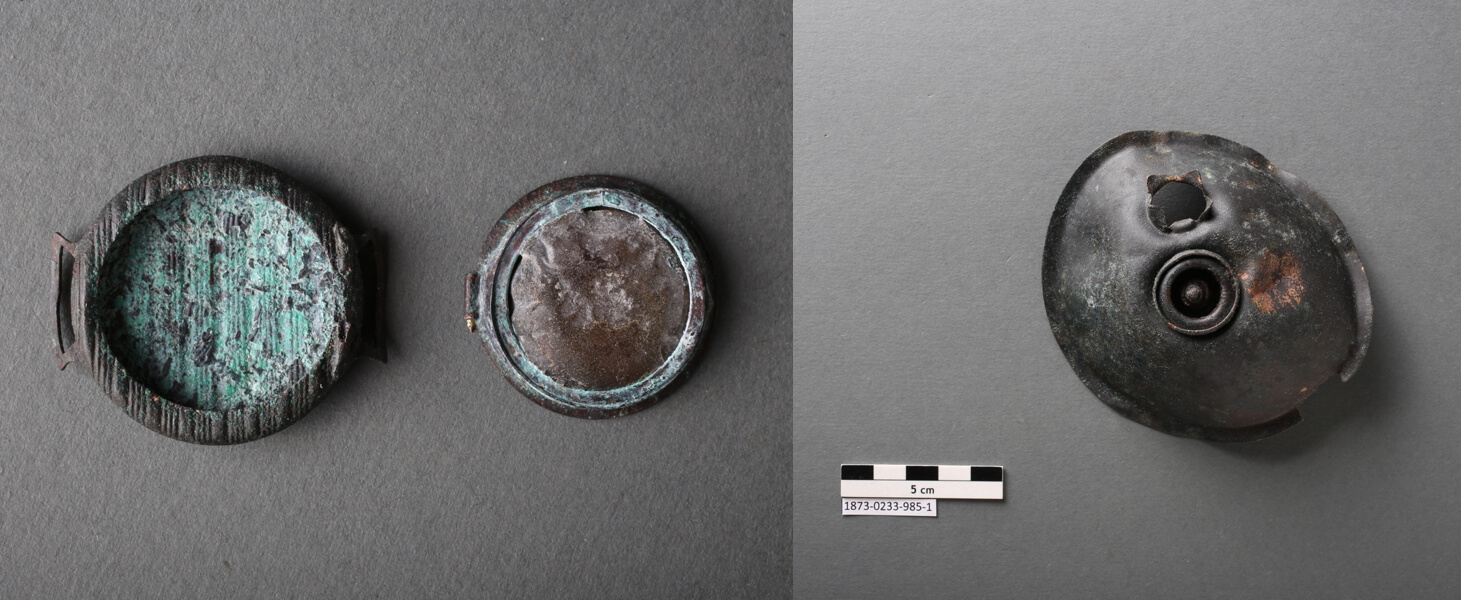Near the end of the Cold War, high school students from the German city of Witten visited Dachau concentration camp to learn about the Holocaust. Walking among the still buildings, they gazed at plaques that described the horrors there, when suddenly they encountered a familiar name: Witten. Just outside their city, the Nazis had built affiliated camps. But why had the students never heard this? Upon return to their city, they demanded to learn more. The city took action, soon identified the location, and archaeologists came to excavate and preserve the site. But it was citizens who first insisted on addressing this history.
The Nazis left rolls of data, documents and more. For decades, historians have relied on these sources along with eyewitness testimonies to narrate the events of the period. But nearly 80 years later, those memories capture only certain aspects of the war, and gaps remain in our understanding.
During the summer of 2012, Reinhard Bernbeck and Susan Pollock of Berlin’s Freie University began excavations at the Tempelhof Airport in Berlin, the site of one of the first Nazi concentration camps and once an important location for Nazi airplane manufacturing. In a time of resurging anti-Semitism and reinvigoration of neo-Nazi parties, Bernbeck says that an archaeology of the Nazi era is critically important; the Tempelhof project has served as a model for such work. Bernbeck wrote about the challenges of conducting an archaeology of the Nazi period in the 2018 Annual Review of Anthropology. His conversation with Knowable has been edited for length and clarity.
What is Nazi-era archaeology?
When I talk about this, people think about Nazi archaeologists digging old things. The Nazis did use forced labor to do archaeological excavations, but I have to insist, “No, no, it is investigating the things that were built and destroyed from 1933 to 1945.” Nazi archaeology is to ask questions about what happened in Nazi times and research them with archaeological methods.
Did this research grow out of other scholarship investigating the Holocaust and the Nazi regime?
This archaeology originally came from civil society, not scholars. For example, there was a place where the Reichssicherheitshauptamt, the center for Gestapo security police, was located. That was known to have been a complex of buildings, at the edge of West Berlin at the time. City officials said, “Oh well, nothing is there.”
But the community insisted they did not believe what the government was saying. One day in the 1980s, they went there and began digging. They found the remains of basements. It is well-known to tourists today: a museum called the Topography of Terror.
What brought you to this field?
I was teaching in the United States, at the State University of New York at Binghamton. I was in a department of anthropology with all kinds of other archaeologists, including colleagues who worked on the archaeology of the 19th and 20th centuries in the United States.
But in Germany, there are the old archaeology disciplines: Classical, Mediterranean, some prehistory. Archaeologists have little sense to explore modernity archaeologically. It was not difficult to perceive that there is a gap.
And, to be honest, it is also personal background. My family was involved to some extent in the camps of the Nazi period. I know that my father was in a prisoner of war camp in North Africa. This is still talked about in private. It’s worked through over and over, in different ways. So, to me, this is still a present problem.
Can you tell us a little more about the methods used in this archaeology?
One method we use is excavation, actually digging in the ground, but what must follow next is identification, cataloging and interpretation. When we excavated at Tempelhof Airport in Berlin, we knew that next to the concentration camp, there was primarily a forced labor camp. We were able to add more detail to our understanding of that camp when we discovered barbed wire laid out underground. While the majority of the people forced to live in the camp were Soviet female civilians, we identified additional areas for Soviet and French Allied prisoners of war. The Nazis issued a specific instruction about how to fence in Soviet prisoners of war, which included installing barbed wire underground; this made it clear these were POWs.

Reinhard Bernbeck at the archaeological site at Tempelhof. Bernbeck is positioned in the entrance to a former air raid shelter of a Lufthansa forced labor camp.
CREDIT: DPA PICTURE ALLIANCE ARCHIVE / ALAMY STOCK PHOTO
What kinds of questions might an archaeologist research at an excavation?
One might ask: How different, or how similar, was life for male French prisoners of war, male Soviet prisoners of war and the Soviet women, who were all living next to each other in that camp? You cannot find that out by asking people, because it is not easy to find anybody. You also cannot find it out through above-ground, non-invasive research. Rather, you have to dig. And if you dig, you have to do it in a way that you do not open too much of the ground, for environmental, financial, practical and legal reasons.
We have built a database with 90,000 artifacts to answer these questions and search for statistically significant differences. We have looked through mass finds such as rusty nails, molten glass (from when a firebomb destroyed the camp), and other such things that pertain to structural characteristics — not so much personal belongings.
When we investigated three neighboring barracks, we looked for tableware that was originally meant for German personnel but somehow got into the camp in low numbers. The French POW barracks and the Soviet one next to it had similar densities of these soup plates, while the second Soviet barracks further down had many fewer such plates. Somehow, the POWs were able to share these things across fences, but there is a distribution inside the site of the Soviet POW section that is quite unequal. The fact that plates got into the POW camps at all means that the Nazis were unable to completely push through their dehumanizing ways of categorizing people.

Locks and part of a fence excavated at Tempelhof.
CREDIT: JESSICA MEYER / LANDESDENKMALAMT BERLIN
In the women’s part of the camp, quite a bit of simple jewelry made of glass and brass showed up. This is almost entirely from the anti-air-raid trench for these women, who obviously used the trench to hide their valuables there. Examples include a glass part of a brooch and a small piece of metal with two birds kissing each other.
How do archaeologists handle these artifacts?
In doing this work, archaeologists often have to reflect: How invasive can they be? Often, there are unexpected finds. So even at my own university here in Berlin, they were doing some work with the sewage pipes, and then they found human bone. It came out that this was behind the so-called Kaiser Wilhelm Institute for Anthropology, Human Heredity and Eugenics, founded in the 1920s and one of the main institutions providing the Nazis with a pseudo-scientific background for their racist ideology. It is known that the director had a student who was none other than Josef Mengele [the Nazi doctor who conducted human experiments at Auschwitz].
But there is just as much suspicion that these bones came from the German colonies in Africa and the Pacific. And so, what can you do? When you find something like that accidentally, you have to deal with it one way or another. But invasive research, such as DNA analysis into these bones, I think is wrong. Using them for anthropological or physical anthropology research would be repeating the same thing the Nazis did before. This finding is still so new that we do not yet have an answer. This anthropology institute did not survive the Nazi times.
How does archaeology reveal more about the past than we can see in texts and archives?
We know a lot about the Nazi period. But when you look into the archaeological details, there is often a difference between what we know from documents, what the Nazis were planning, and victims’ memories. Before we dug, no one knew what kinds of people from Russia were in these barracks. Normally, one would assume civilians, as the Nazis tried to let the POWs starve to death (3 million died in horrible circumstances from simply not being fed in the first six months after the Wehrmacht attacked the Soviet Union). So we were quite astonished to learn they were Soviet POWs. Later, we found a letter where one manager of the aircraft manufacturing company Weserflug, who used the Tempelhof laborers, complained about the undernourished labor they were given by the government.

Archaeologists excavating barrack foundations at Tempelhof.
CREDIT: EDWARD COLLINS, JAN TRENNER / LANDESDENKMALAMT BERLIN
In another example, Lufthansa, which also used forced labor at Tempelhof, was provided with cement for foundations of barracks for its laborers. We excavated parts of one of these barracks. The lowermost level of concrete was solid and well done, while the layer above was crappy material, full of stones, broken old concrete mixed with lots of sand and an insufficient amount of cement. So — did they not receive enough? Archival documents say that they did. First, the difference makes clear that paperwork tended to be a formality rather than mirroring reality. Second, the camp director likely diverted material for his own profit. Corruption is found in these camp contexts: Archival documents of other camps include complaints by forced laborers that camp directors took away meat and other food. So why not also cement?
There is also the possibility that the forced laborers themselves set cement aside to sell on the black market; they were supposed to build the barracks themselves, the documents reveal.
What are some of the other discoveries archaeologists have made?
There is a tendency to excavate what I would call context fixtures, that is remains of barracks, immobile structures in the ground. That happens because these things need to be excavated by law in most states in Germany. However, I would say that focusing on those things misses the point, because we have plans for many, though not all, of these structures.
What is much more important is to document the objects that are in these places, in the position where you find them.

Other finds at Tempelhof include two parts of a medallion (left) and the remnant of a hand lamp (right).
CREDIT: JESSICA MEYER / LANDESDENKMALAMT BERLIN
Preservation plays a huge role in what we can learn. In the huge forced labor camp at Tempelhof, an incendiary bomb fell on one of the wooden barracks. Almost the entire thing burned down at the beginning of 1944. As far as we can tell, people were not in the barracks at the time, and so all the stuff that was in there was left on the ground. When we excavate, we find a lot of things in place. This is not the case for most other camps.
Many of the objects cannot be associated with specific individuals, but there was a rosary in Tempelhof in the shelter in the women’s part of the camp. The object evokes a past much more concretely than a text: One can imagine a woman anxious about surviving a night in that ditch while bombs were raining down on Tempelhof. We found two wedding rings in the area of one of the barracks for Soviet POWs (cheap, not gold or silver). Apart from reminding us that POWs were not just men in a war, but often had direct family, the questions are also: Why were they not worn, why left in the barracks? Because the person had extramarital affairs in the camp? Is that possible? Or because they were not allowed to wear them when working with electric drills and other tools? The latter is more likely, of course, and reminds us that there was a lot in the life of the POWs and forced laborers that may have been important to them but does not appear in written documents: They were not relevant for Nazi officials, and people who wrote home did likely not mention such things either.
What is the future of this field?
On the one hand, my hope is that, specific to Germany, academia begins to understand the need for an archaeology of the Nazi period. There is a need for people who study the history of modernity to include archaeological methods. So far, in Germany, that doesn’t exist, although it exists very much in the United States.
On the other hand, when I look into the future, quite frankly I’m concerned with the Europe-wide move to the right. Since the 1990s, Nazi archaeology has been a field supported by state agencies. And German law sometimes gives elected parties seats in institutions that decide on the distribution of money for cultural events — not on a federal level, but on a regional one. It is here that most of the damage could happen. Memorials at concentration camps are, as far as I know, federally managed, as required by the treaty between the four powers (the US, USSR, Great Britain and France) during reunification negotiations. But that does not apply to more local effects on heritage preservation. Our excavations were funded by the city council of Berlin. If [the far-right political party] AFD was in government locally, that would change a lot. That could happen in 2019 in Saxony.
In Tempelhof, the megalomaniac airport of the Nazis still stands, and is so monumental that even the thought of taking it down would be daunting, and now, of course, it is a registered state monument. On the other hand, the barracks are entirely gone, invisible except for a few small signs on the huge airfield. This is the political dimension of preservation: The materiality of the powerful survives, even when the regime itself has disappeared long ago, while that of the victims is gone. This is not new for any archaeologist, but it’s worth repeating over and over again, because we tend to forget it.
With this kind of archaeology, you have to be politically engaged. You take a stand to speak about the atrocities, and the stories of the victims. I would hope so, anyway.




